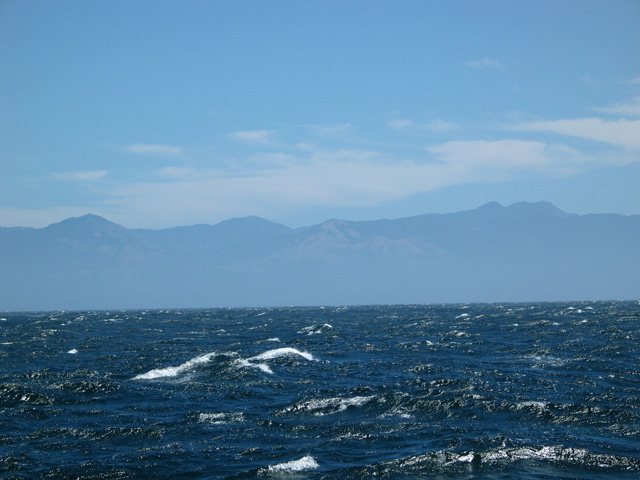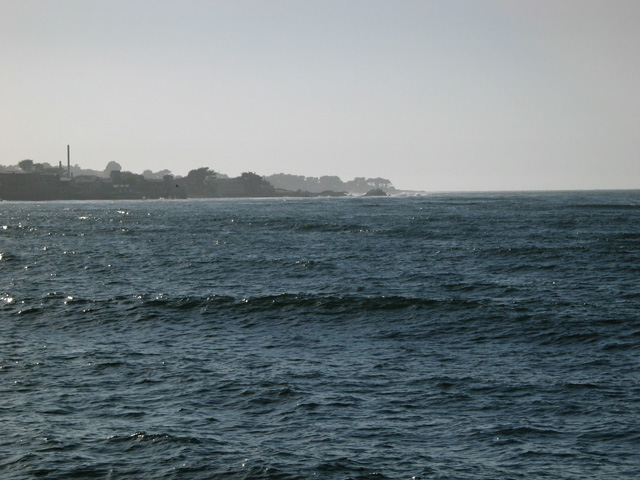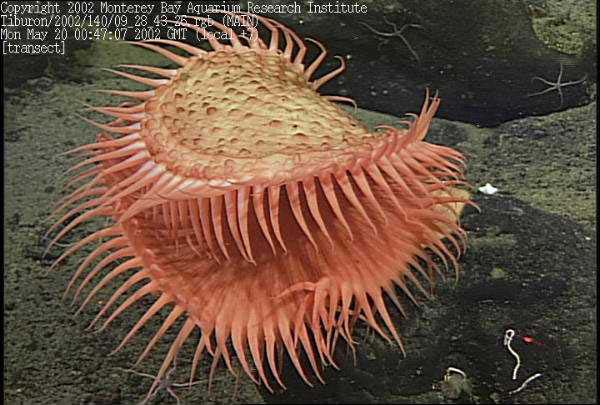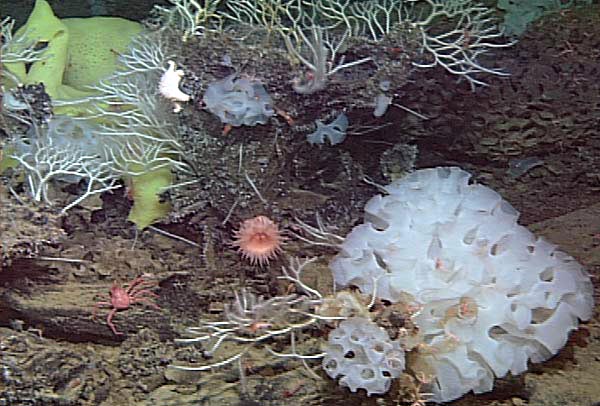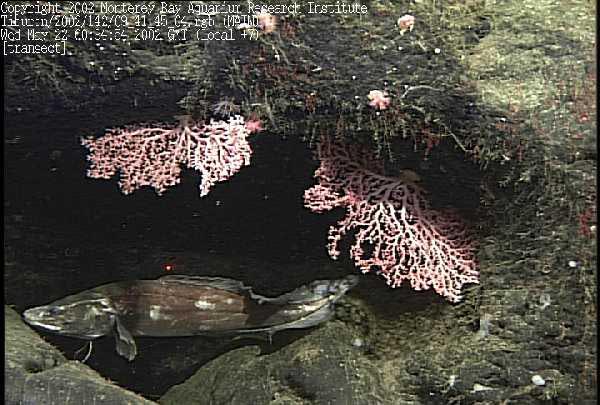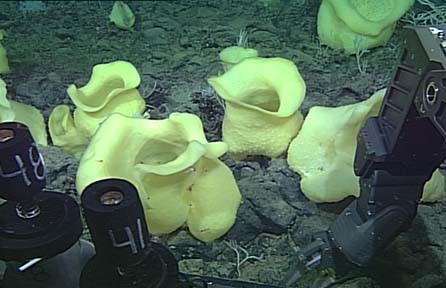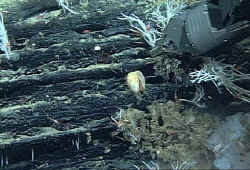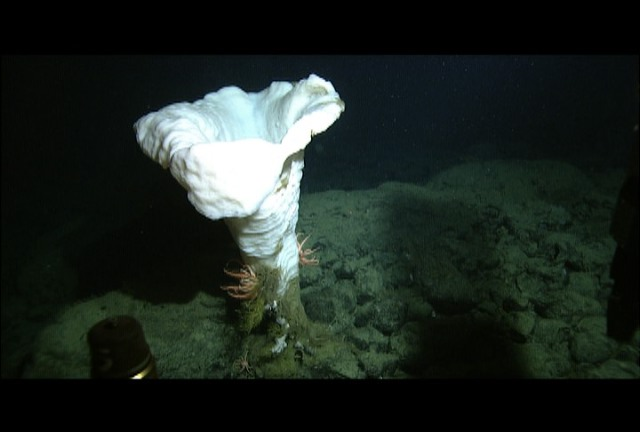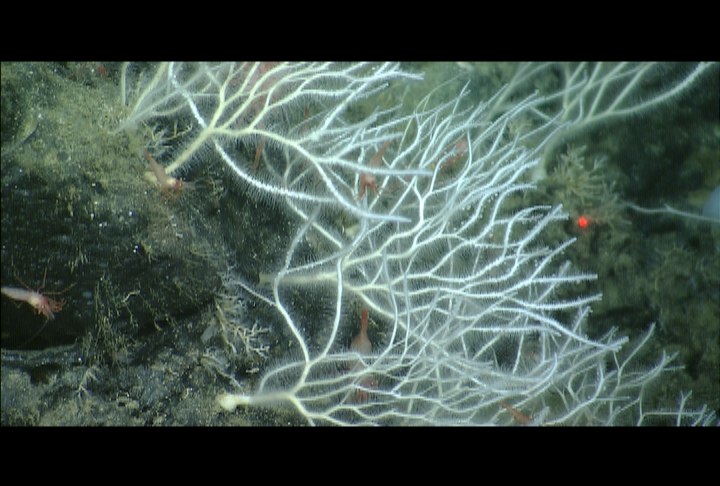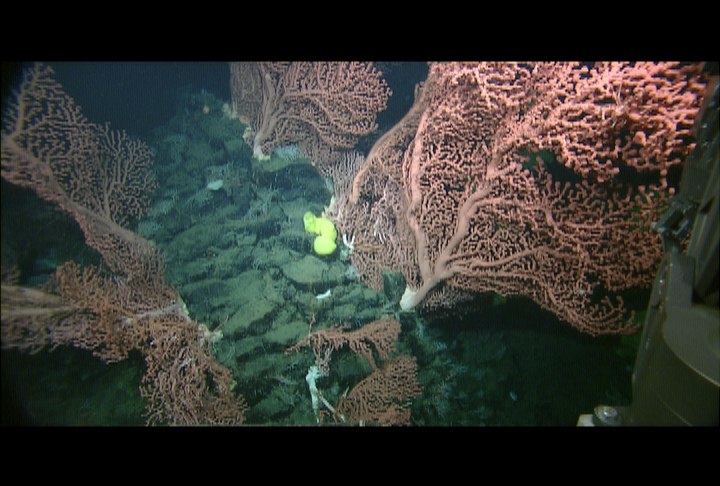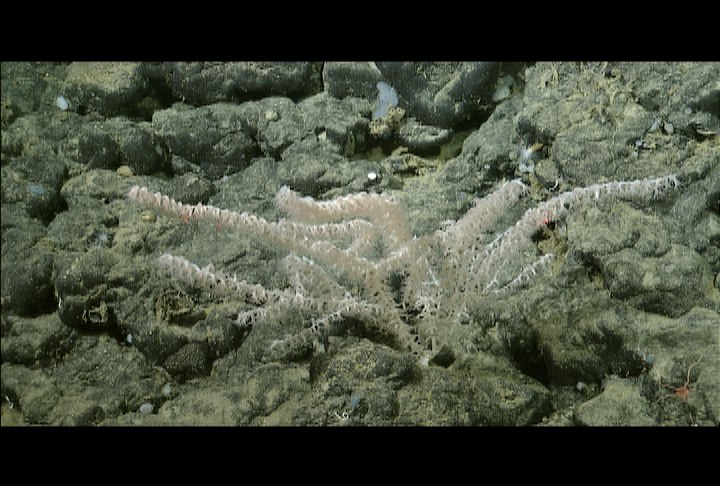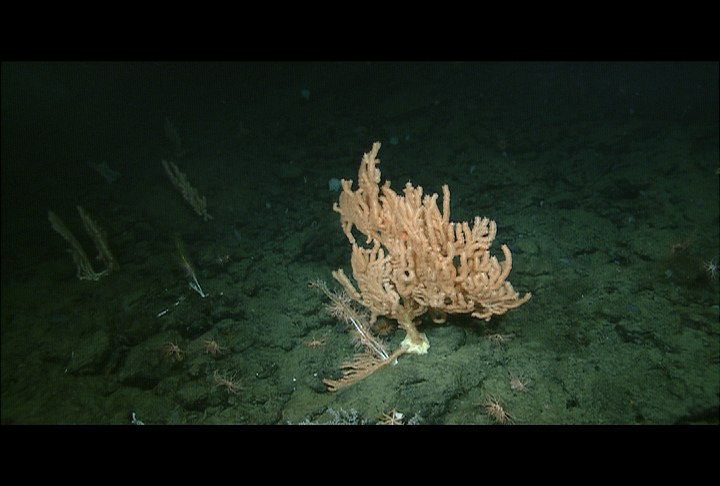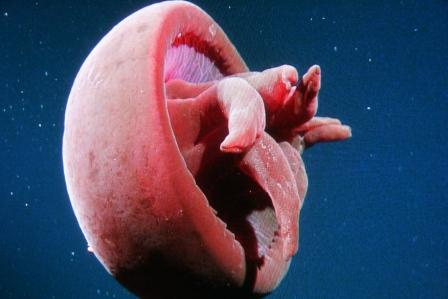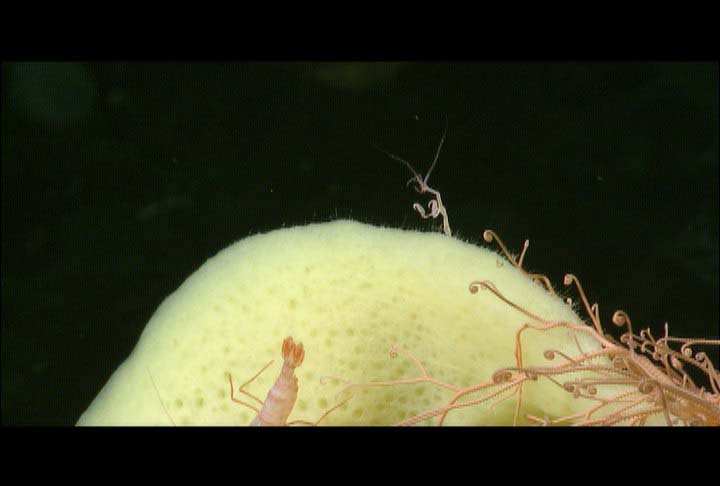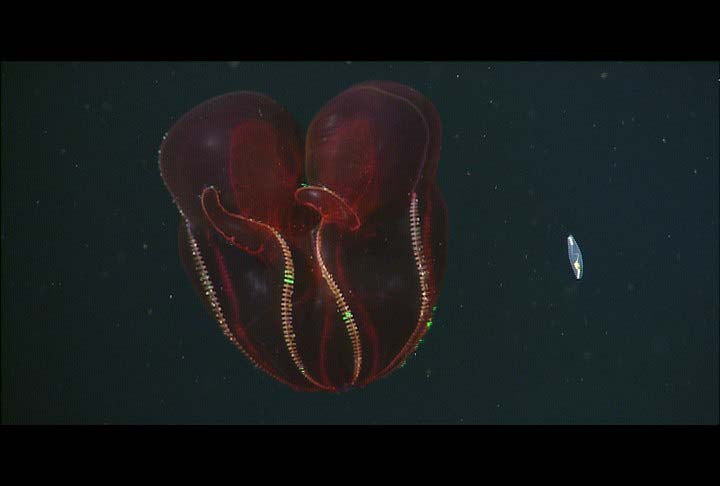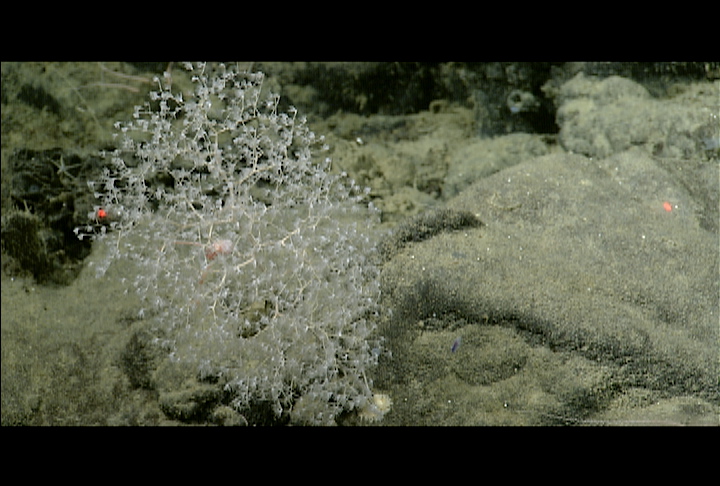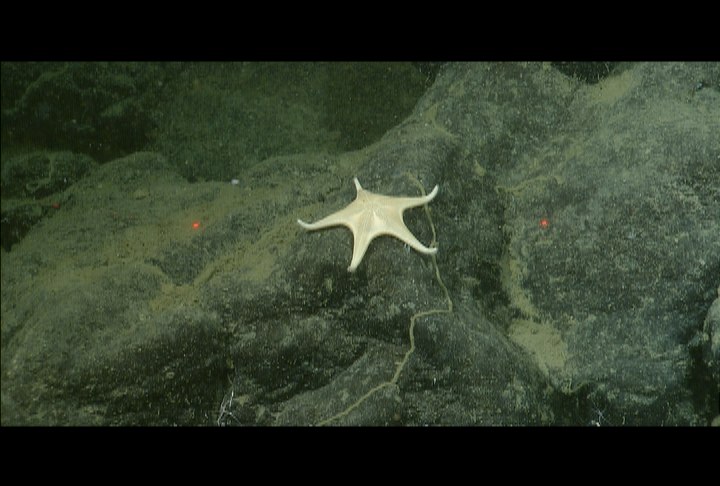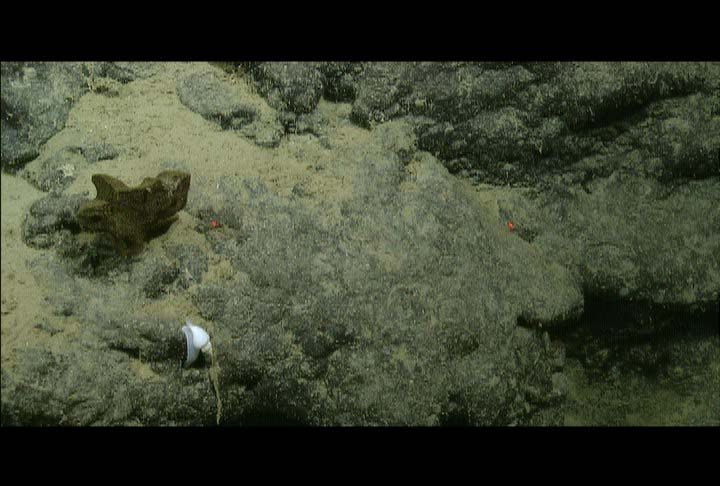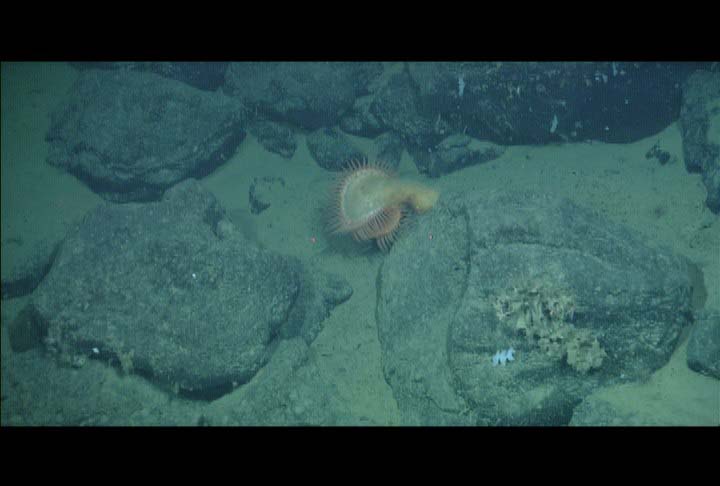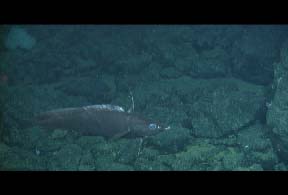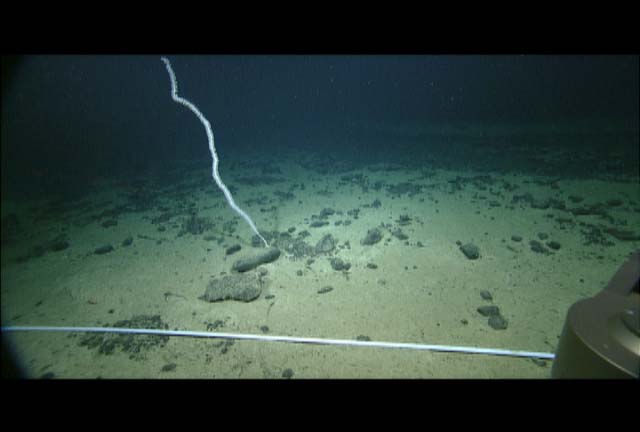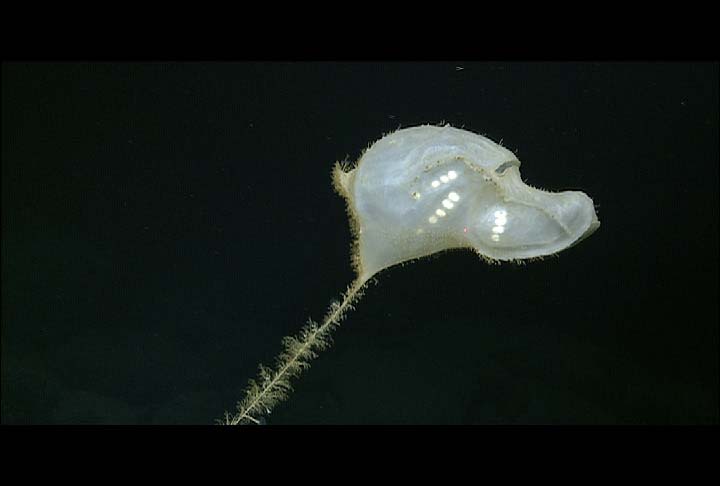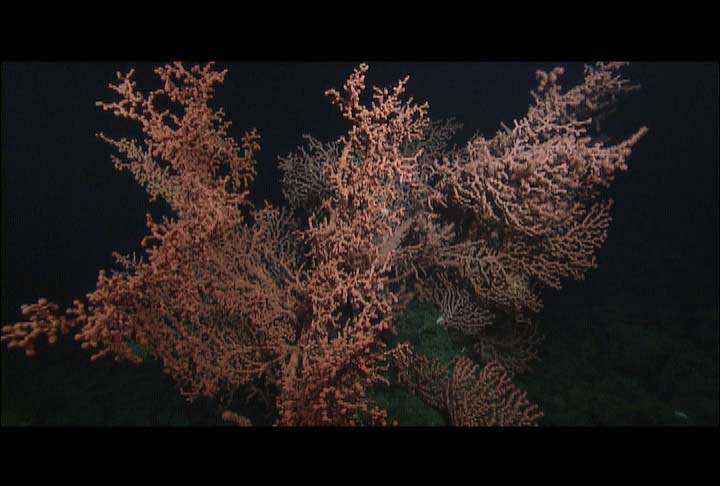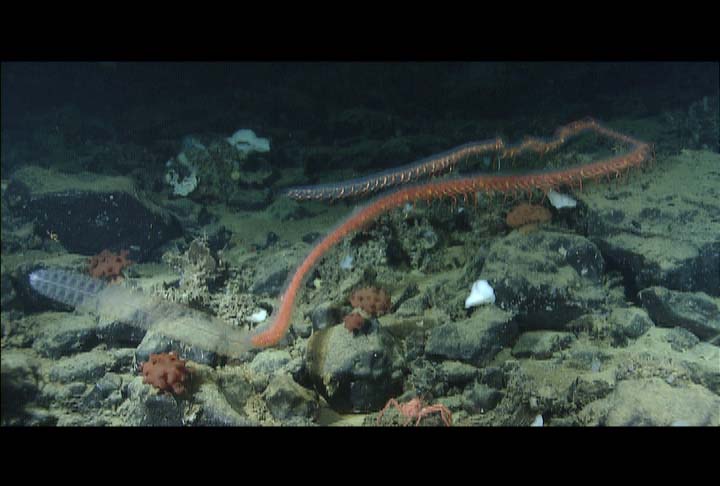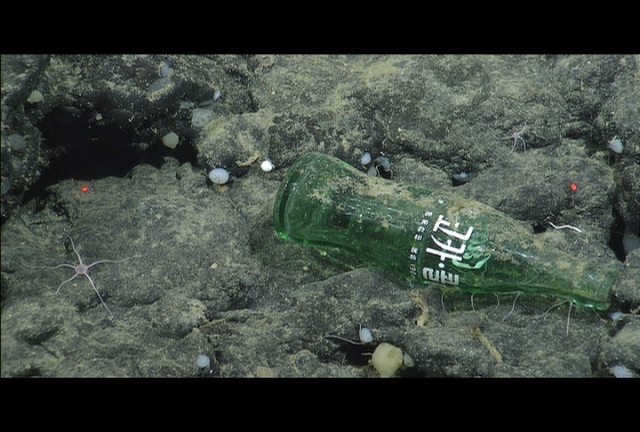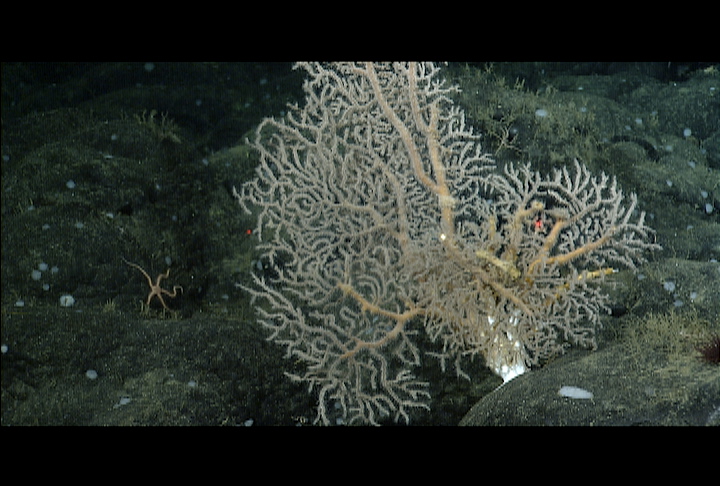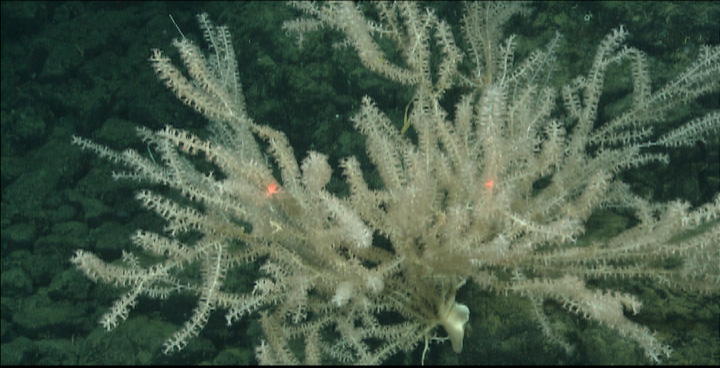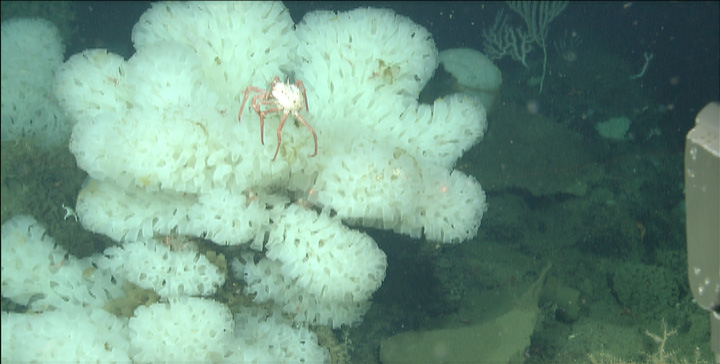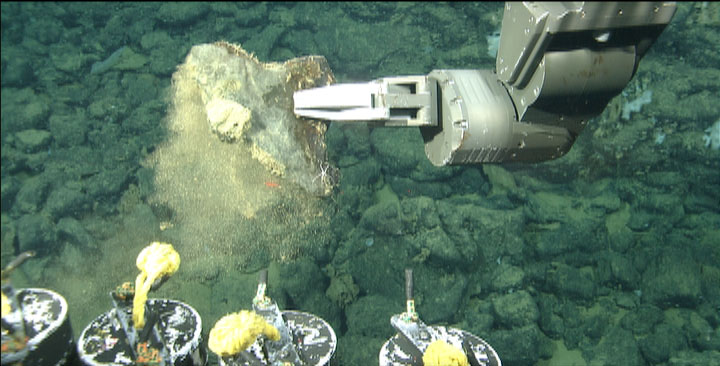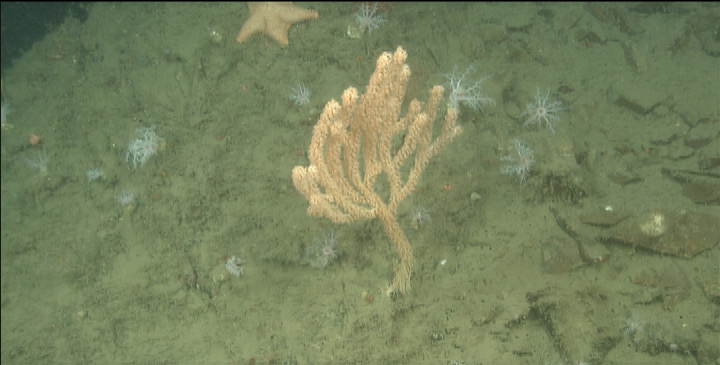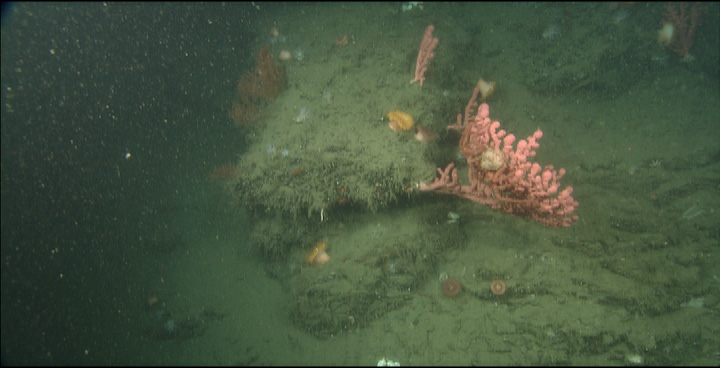 | Davidson Seamount |
Located 120 kilometers to the southwest of Monterey, Davidson Seamount is 42 kilometers long and rises 2,400 meters from the ocean floor, yet is still 1,256 meters below the sea surface. This large geographic feature, discovered in early seafloor mapping efforts, was the first to be characterized as a "seamount" and was named after scientist George Davidson of the Coast and Geodetic Survey (forerunner to National Ocean Service of the National Oceanic and Atmospheric Administration). MBARI created high-resolution maps of Davidson Seamount in 1998 during its mapping project. |
Big Sur |
view of Monterey |
flytrap anemone at Davidson Seamount |
As vertical relief increases, animal life explodes. (Image courtesy Monterey Bay Aquarium Research Institute (MBARI). Vent relief |
A cusk eel takes refuge in a crevice, under an umbrella of gorgonian corals. Image courtesy of Davidson Seamount Exploration 2002, NOAA/OER |
On the southern slope of the 1270 m, cone - numerous sponges |
a large clam with the manipulator arm of the ROV Tiburon - http://www.mbari.org/expeditions/Davidson/clam_sample.mpg |
a depth of 1500 meters and were only able to test the manipulator-held current meter as our bottom time was very limited. Before aborting the dive at around 8 PM we observed several species of coral including Acanthogorgia, Anthomastus ritteri, Antipathes, Corallium, Keratoisis, and Parastenella. We also observed several different sponges including a very large white trumpet sponge which had several brisingids clinging to it. Other organisms encountered on this brief visit to the sea-floor included a few species of King crab (Lithodidae), a dense aggregation of basket stars (Gorgonocephalus), and several different species of sea star. |
. The seafloor that we surveyed today was dominated by huge bubblegum corals, white ruffled sponges, and an unusual branched sponge. the particular sponge is likely a new species in the genus Asbestopluma) that we previously encountered but had not sampled |
Paragorgia - the pink bubblegum coral |
Objectives for the day: benthic transects, manipulator-held current measurements, Niskin water samples, coral samples from Big Valley, bamboo coral collections on Bamboo Ridge, ascend to peak for final transect. We saw many Coral Gardens on the ridges, peaks, and valleys of Davidson Seamount. We dropped down to 1750 meters and took several current measurements and then began a 180 m transect on the rocky edge of the valley floor. We ended this transect by taking a push core of the gravel and mud in a sediment pool, sampling a white trumpet sponge and a rock for MBARI scientist David Clague. Surprisingly, we found many more corals than we had expected to on this transect. We saw what appeared to be several species in the family Primnoidae, many Corallium, and many small but beautiful bamboo corals called Acanella |
a Primnoidae that appeared to be overgrown with a colony of zoanthids well see when the sample comes up! We sampled a gold gorgonian, Acanthogorgia, as well (see image to left). The geology on the last portion of the 2nd transect was not what we were expecting to see. We had expected mostly flat sediment, however, pillow lava and some angular talus covered the benthos. We began the ascent up to Bamboo Ridge from Big Valley where we finally saw the large bamboo corals Keratoisis, which Allen Andrews is using for age and growth studies. We sampled a community of Keratoisis, took some Niskin water samples, and current measurements in the vicinity of the Keratoisis community. We finally made the ascent to the ridge at 1500 meters and found several very large bubblegum corals, Paragorgia arborea, clinging to the edge of a vertical face, where current velocity appears to be highest. We took several more current measurements around the bubblegum corals and started our ascent. We were able to film a Big Red jelly, Tiburonia granrojo, in HD before finally returning to the R/V Western Flyer for the evening |
Keratoisis |
Tiburonia granrojo - a new species described by researchers from MBARI and from the Japanese Marine Science and Technology Center (JAMSTEC). This amazing jelly gets up to 1 meter in diameter and is found throughout the Pacific Ocean |
a caprellid amphipod standing upright on a yellow Picasso sponge basket stars dorsal surface, and several other interesting critters |
midwater organisms including the red lobate comb jelly - Lampocteis (see image to the left), several siphonophores, an Aegina citrea, a midwater octopus, a Sawtooth Eel, and a Tomopteris polychaete worm. |
at a water depth of 2800 meters. Swift currents, even at this depth, seem to bring nutrients to a surprisingly diverse coral and sponge-dominated assemblage. Upon touching down we saw a variety of invertebrates that we immediately began sampling. We found several large enteropneusts (a hemichordate), a large sabellid worm, several Lepidisis bamboo corals (see image to right), a stalked sponge, and many small gastropod snails. Nearby, we found sediment as we had expected and then push-cored the gravelly substratum along with an unusual pink sea cucumber. |
black corals, unusual sponges, Chrysogorgiid corals, and a multitude of yellow stalked sea lilies |
towards the cone at 2300 meters. The terrain at the summit consisted of pillow lavas and talus. The biota consisted mainly of the crinoid Florometra, lithodid crabs, and sea cucumbers. We were surprised by the lack of corals at the summit of this cone, as we had expected to find a lush coral garden as has been the case on other, shallower summits |
in 2800 meters.contained occasional lava outcrops and elongate pillows. We transited through midwater to arrive on the slopes of a sister cone, which was nearly identical to the other in size and composition, though its peak was slightly shallower at 1700 meters. The sea star Ceramaster (see image to right) and sea cucumber Laetmogone were the most commonly seen megafauna upon the talus slopes today. We saw only a few corals including Anthomastus ritteri, a few Primnoids, Lepidisis and single Acanthogorgia |
several species of sponges, though not nearly as many as we did on previous days. NOAA scientists collected several interesting specimens including a beautiful gastropod , an unusual sea urchin, and a very strange organism which we are suspecting might be a xenophyophore |
a fly-trap anemone several Bothrocara brunneum, Spectrunculus grandis and an Aldrovandia |
several species of fish including an Antimora microlepis |
in 3,200 meters water depth in the deep southeast of the Davidson Seamount at the Big Easy. The seafloor was mostly mud with some volcanic talus scattered about on the surface giving it the appearance of a lunar landscape. Within minutes of touching down we observed several very bizarre mud walls, which appeared to be the cause of a combination of uplift and erosion.a very large Lepidisis coral and noticed a submarine cable |
corals from the families Chrysogorgiidae and Primnoidae, several species of crinoids, several species of sea cucumbers, a benthic siphonophore, and an unidentified mollusk, which may have been a sea hare. Unfortunately the unidentified mollusk escaped because after we dislodged it from the rock it was sitting on it began floating and quickly disappeared. |
At the peak of Big Easy in 2,300 meters water depth, we found an amazing coral garden that was incredibly diverse (see image left). The community included antipatharians, primnoids, paragorgids, cup corals, sponges, crinoids, the stalked tunicate Culeolus, small bryzoans, crabs, and pycnogonids. |
Culeolus |
Swift Valley where we cut loose our moored current meter Coral Gardensat 1700 meters. The BBC found amazing communities of bubblegum corals, sponges, and a host of other invertebrates |
They also filmed a midwater siphonophore (see image right) that happened to be trapped on the benthos. Most likely a current deposited this unfortunate siphonophore upon the crest of the seamount where it will quickly be treated as any other food parcel in the deep sea eaten with haste. The BBC spent the rest of the afternoon and evening filming midwater organisims including another siphonophore and several jellies. Its been a productive day and were all looking forward to tomorrow''s exploration at Long Ridge. |
peak in 1500 meters water depth at the southern portion of the ridge. We sampled a variety of corals, including the bamboo coral Keratoisis, the precious coral Corallium, and the bubblegum coral Paragorgia. We also sampled an unusual coral which none of us had ever seen before, which always makes for a truly exciting day. We saw several pink snailfish, large white trumpet sponges, goiter sponges, yellow and white ruffled sponges, a stalked tunicate, little yellow tunicates, several species of primnoids, basket stars, crinoids, and many species of sea stars. We also found a foreign Coca-Cola bottle! |
A primnoid coral |
unusual coral (name to be determined) |
Some of the marvelous corals that we have been able to examine during this expedition. Paragorgia arborea is the pink coral to the upper left (this is the one covered with basketstars mentioned in the text above |
at Tip-Top and midwater. fish including a California Slickhead (Alepocephalus tenebrosus) and a Blob Sculpin (Psychrolutes phrictus). |
Looking down at a bamboo coral Keratoisis sp. from yesterday''s dive at Davidson Seamount. The red laser dots are 29cm apart for scale |
Unidentified white sponge being picked over by a lithodid crab |
Sampling a piece of lava with the manipulator arm of the ROV. |
Bamboo coral Isidella and sea cucumbers Psolus (white tentacles) clinging to the mud-draped canyon wall |
Pink Paragordia, red Swiftia coral and several anemones on sedimentary rocks |
From MBARI -
http://www.mbari.org/expeditions/Davidson/index.htm
http://oceanexplorer.noaa.gov/explorations/02davidson/davidson.html
http://www.mbari.org/expeditions/Davidson06/index.htm
Diversity of Animal Life on Seamounts
Edward W. Seidel
Associate Curator, Monterey Bay Aquarium
After observing deep-sea areas on and around seamounts for even a short time, one notices a stark pattern of where to find animals. Flat areas are a virtual desert with very little animal life, but as soon as there is some vertical relief, an oasis of animals explodes into view. Even something as small as a volleyball-sized rock is enough to become a haven for animal life.
This phenomena occurs for two basic reasons: Seamounts provide structure for animals to live on, and the structure creates oceanographic effects that promote the production of food. Many of these deep-sea animals, such as gorgonians, mushroom corals, and sponges, spend their entire lives permanently attached to rocks, and therefore depend on ocean currents to bring their food to them. A seamount, rising up out of the sea floor, has strong currents that frequently run over it, providing the animals living along its flanks with a constant supply of planktonic food.
These same currents also produce localized upwelling of water around the seamount. Nutrients like nitrates and phosphates, which are critical to the growth of phytoplankton, are lifted from the deep to the sunlit surface waters. These nutrients fuel an explosion of planktonic plant and animal growth, and attract larger animals such as whales, sharks, tunas, and seabirds to a veritable feast.
Seamounts are hot spots of biodiversity. Think of a seamount as an underwater island. Ocean currents carry larvae, like shipwrecked mariners, from various geographically distant areas. Seamounts provide a place for these lost larvae to settle and grow, so you find animals living side by side that normally are not found together.
Davidson Seamount is geologically young but has remarkable biological communities, including large, dense patches of sponges and apparently extremely old coral forests, with individuals commonly reaching more than 3 m in height. Rare species, such as the black-footed albatross and the federally listed endangered sperm whales, have been sighted at the seamount. Two commercial fisheries currently operate in the waters above Davidson Seamountdrift gill netting for swordfish and sharks and trolling for albacore tuna. It is not known how or if these fisheries impact other species at the seamount. Its proximity to numerous fishing ports and the developing technologies in deep-water fishing make Davidson extremely vulnerable to increased fishing pressure
http://oceanexplorer.noaa.gov/explorations/02davidson/background/diversity/diversity.html
Biodivercity - http://www.mbari.org/expeditions/Davidson/animals_geology.mpg
Coral forest - http://www.mbari.org/expeditions/Davidson/coral_slope.mpg
Sponges
http://plate-tectonic.narod.ru/2Aphotoalbum.html
Diversity of Animal Life on Seamounts

